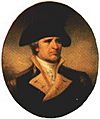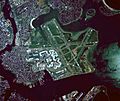Battle of Chelsea Creek facts for kids
Quick facts for kids Battle of Chelsea Creek |
|||||||
|---|---|---|---|---|---|---|---|
| Part of the American Revolutionary War | |||||||
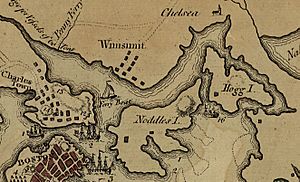 Map of the battle location. Chelsea Creek separated the islands from Chelsea on the mainland to the north. The schooner Diana is represented by the burning vessel labeled "16". It was in Chelsea Creek during the battle and was never at the location indicated. It burned north of the boat labeled "Ferry Boat." |
|||||||
|
|||||||
| Belligerents | |||||||
| Massachusetts Bay | |||||||
| Commanders and leaders | |||||||
|
|
Israel Putnam | ||||||
| Strength | |||||||
| 850 Royal Marines (Samuel Graves). 30 on the Diana (Thomas Graves). These are rough estimates. | 300–600 in initial force to Hog Island (Stark). 300 additional reinforcements during the course of the battle (Putnam). These are rough estimates. | ||||||
| Casualties and losses | |||||||
| 2 killed, 32 wounded, Armed schooner Diana destroyed |
4 wounded | ||||||
The Battle of Chelsea Creek was an important fight during the American Revolutionary War. It was the second big battle of the Boston campaign. This battle is also known by other names. These include the Battle of Noddle's Island and the Battle of Hog Island.
The fighting happened on May 27 and 28, 1775. It took place on Chelsea Creek and nearby islands in Boston Harbor. These areas had lots of salt marshes and mudflats. Today, many of these areas are part of the mainland. They are now places like East Boston, Chelsea, and Winthrop.
The American colonists had a clear goal. They wanted to make the siege of Boston stronger. They did this by taking away farm animals and hay from the islands. This stopped the British soldiers from getting supplies. They also destroyed a British ship called the Diana. The colonists took its weapons. This was the first time they captured a British ship in the war! It made the colonists feel much more confident.
Contents
Why did the Battle of Chelsea Creek happen?
The Battles of Lexington and Concord happened on April 19, 1775. After these battles, thousands of militia (citizen soldiers) came to Boston. They surrounded the British forces in Boston. This created a siege. The colonists blocked all land routes into the city.
However, the British could still get supplies by sea. Ships brought food and other goods from places like Nova Scotia. The British navy controlled the harbor. The colonists did not have a navy yet. But there was one area still supplying the British. This was the islands and coastal farms near Boston.
Farmers on these islands were in a tough spot. If they sold food to the British, the colonists would see them as Loyalists. If they refused, the British would just take what they wanted. So, on May 14, the Massachusetts Committee of Safety made a plan.
They decided to remove all livestock from islands like Noddle's Island and Hog Island. They also wanted to clear animals from coastal areas of Chelsea. This would stop the British from getting these supplies. Joseph Warren and Artemas Ward checked the islands. They found many animals but no British troops.
A few days before, the British tried to get hay and animals from Grape Island. Local militia drove them away. The militia then burned the hay. This showed the colonists were ready to act.
The British Navy in Boston was led by Samuel Graves. The Royal Marines were under John Pitcairn. The overall British commander was Thomas Gage. Graves had important naval supplies stored on Noddle's Island. He wanted to protect them.
How did the battle start?
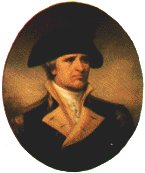
Vice-Admiral Graves knew the colonists might attack the islands. So, he placed guard boats near Noddle's Island. These boats had Marines on them. It's not clear if British soldiers were actually on Noddle's Island itself.
The colonists' plan involved John Stark and his 1st New Hampshire Regiment. This group had about 300 men. They were stationed near Medford. Stark followed orders from General Ward. Just after midnight on May 27, Stark and his men crossed the Mystic River. They marched north through Malden and other towns. More local men probably joined them.
Hog Island could be reached at low tide. Soldiers could walk across Belle Isle Creek. The British guard boats did not notice them.
Around 10 am, Stark moved his main force to Hog Island. Most of his men gathered the farm animals there. Stark himself took about 30 men to Noddle's Island. They killed animals they found. They also set fire to haystacks and barns.
What happened during the battle?
Fighting on the Islands
The British noticed the smoke from the burning hay. Vice-Admiral Graves saw the smoke from his ship, HMS Preston. This was around 2 pm. He ordered his Marines to land on Noddle's Island. They quickly started fighting Stark's scattered groups.
Graves also sent the schooner Diana into Chelsea Creek. His nephew, Lieutenant Thomas Graves, commanded the Diana. The ship's job was to help the Marines and block the colonists' escape. About 400 Marines landed and pushed Stark's men back.
The colonists ran until they reached Crooked Creek. There, they hid in marshy ditches. They fired at the British from these strong positions. A fierce fight followed. The colonists "Squat[t]ed down in a Ditch on the ma[r]sh" and fought hard. The British Marines eventually had to retreat.
Stark's men then left Crooked Creek. They joined the main group on Hog Island. The Diana and other British ships chased them up Chelsea Creek. By sunset, hundreds of cattle, sheep, and horses were moved from Hog Island to the mainland.
Around sunset, the Diana tried to turn around. It wanted to avoid getting stuck in the shallow creek. But Lieutenant Graves realized he needed help. He sent a signal for assistance. Vice-Admiral Graves ordered barges with Marines to tow the Diana out. The sloop Britannia also came to help.
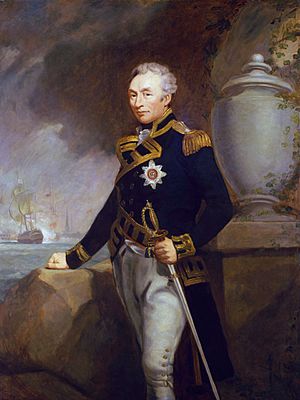
Battle on the Mainland Coast
Some of Stark's men were still moving livestock. Others saw that the Diana was in trouble. They called for more soldiers. General Israel Putnam arrived with up to 1000 troops. Joseph Warren was also with them. They gathered on the shore near the Diana. This area is now part of Chelsea.
Putnam waded into the water. He offered the Diana's sailors a chance to surrender. But the ship kept firing its cannons. The British kept trying to tow it. The colonists kept shooting at the ship. They used two field cannons from the shore. The Britannia and British cannons on Noddle's Island also fired back.
Around 10 pm, the British rowers had to give up. The heavy fire forced them to abandon the Diana. The Diana drifted and got stuck again. It ran aground on the Chelsea coast, tipping onto its side. Lieutenant Graves left the Diana. He moved his men to the Britannia. The Britannia was then successfully towed to deeper water.
American forces quickly boarded the Diana. They took everything valuable. This included guns, ropes, sails, clothes, and money. They put hay under the ship to burn it. The Diana was set on fire around 3 am. This stopped it from falling back into British hands. The guns they took were likely used later. They were probably used at the Battle of Bunker Hill.
What happened after the battle?
This fight was important for the colonists. It was probably the first time they used field cannons in the war. They had no deaths and only a few wounded. Their spirits were greatly lifted. They had successfully captured and destroyed the Diana. This action also helped Israel Putnam. He was later approved as a General in the Continental Army. This battle helped show his leadership.
General Gage reported the British losses to London. He said, "Two men were killed and a few wounded." But other reports were much higher. Some said over a hundred British were killed. The colonists felt very brave after this win.
Gage ordered cannons to be placed on Copp's Hill in Boston. Vice-Admiral Graves moved his ship, the Somerset, to deeper water. This would give it more room to move if attacked. He also sent soldiers to Noddle's Island. But the colonists had already taken or destroyed everything valuable there.
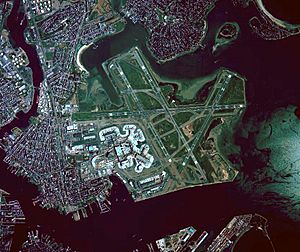
How has the area changed?
The geography of Boston has changed a lot since the Revolution. The islands of Hog and Noddle's are no longer islands. In the late 1800s and early 1900s, the water between Noddle's and Hog was filled in. The water between Hog Island and the mainland was also filled in. Now, only a small, narrow creek remains.
Today, the Orient Heights area of East Boston is where Hog Island used to be. Most of East Boston was once Noddle's Island. Chelsea Creek has become narrower. It has been dug out and straightened for shipping.
People have tried to find the remains of the Diana in Chelsea Creek. But the creek has been changed a lot over the years. No shipwrecks found there have been identified as the Diana. In 2009, the National Park Service gave money to help find the wreck.
Images for kids
-
Map of the battle location. Chelsea Creek separated the islands from Chelsea on the mainland to the north. The schooner Diana is represented by the burning vessel labeled "16". It was in Chelsea Creek during the battle and was never at the location indicated. It burned north of the boat labeled "Ferry Boat."
-
Colonel John Stark led the Colonial expedition.
-
Thomas Graves, who commanded Diana, went on to become an admiral in the Royal Navy.
-
A satellite image of East Boston. The narrow neck visible in the upper left is Chelsea Creek, the boundary between Chelsea and Noddle's and Hog Island. The boundary between Hog Island and the mainland is just out of shot to the upper center. The former boundary between Hog Island and Noddles Island is roughly where the current Constitution Beach is just northwest of the airport



